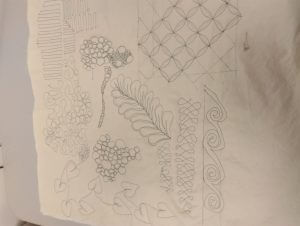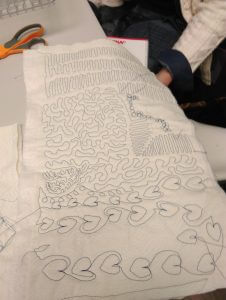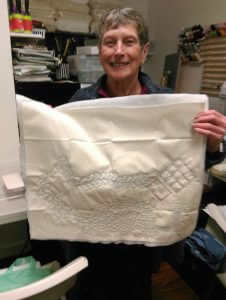Posts Tagged ‘Linda Seward’
Free Motion Quilting!
 Can you tell I love me my unpolished red satin? This is “Mandala 1: Core,” also published in Linda Seward’s book Ultimate Guide to Art Quilting Techniques. It’s free motion quilting, but the nice thing about using marbled patterns is that you have lines to follow!
Can you tell I love me my unpolished red satin? This is “Mandala 1: Core,” also published in Linda Seward’s book Ultimate Guide to Art Quilting Techniques. It’s free motion quilting, but the nice thing about using marbled patterns is that you have lines to follow!
I taught beginning free motion quilting this past Saturday and had a FABULOUS time!! When I did my lesson plan for the class, and then as I was going through it with my students, a few things became very clear to me.
- Everything starts with a straight line done with the free motion foot. It helps develop rhythm and hand placement. No longer will I start with a motif when teaching beginners.
- It’s easy to go from straight line to stippling (large, medium, and micro) as well as figure out how not to get in a corner and have to stop. My students found it very easy to move quickly and easily into curved lines.
- At this point we stopped to talk about threads and tension. It seemed a good point, and there were questions cropping up. The biggest problem they (and probably most of us) have is silencing that Inner Critic and realizing we have to practice – most of us aren’t willing to approach it that way at the beginning. (Ask me how I know that…). One person had bobbin issues, and the rest were concerned with moving that upper tension dial, as well as determining if their machine like same thread top and bottom, or another combination. I need to remember for future classes that “same thread top and bottom” may be more helpful to beginners. I’m so used to the quirks of my machine and how to work with different top and bottom
- Next pattern was a basic heart-shaped leaf, first learned by me in the 2012 Free Motion Quilting Challenge by quilter Frances Moore.
- Pebbles were next – large, medium, fill-ins, different sizes. This seemed a natural progression.
- Then spirals, grid patterns, and feathers. No one really got frustrated, mainly because they could see how previous learning morphed into a new pattern pretty easily.
Lots of samples from me so students could see practical applications within actual quilts, as well as all my practice fat quarters that I now use to practice or check tension before beginning a new project.
Best part? Everyone signed up for Intermediate FMQ in March!


